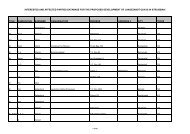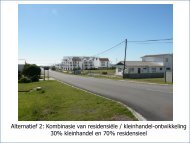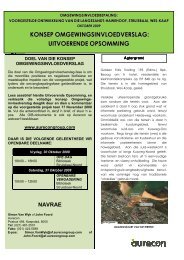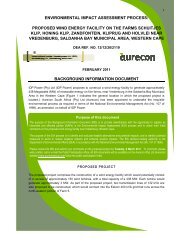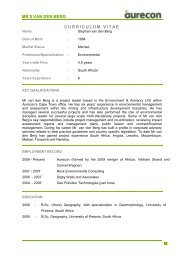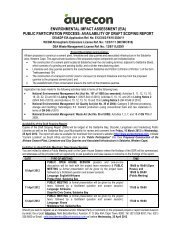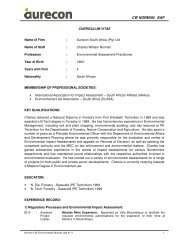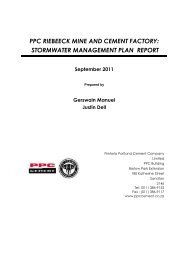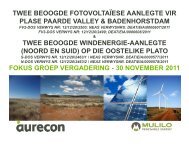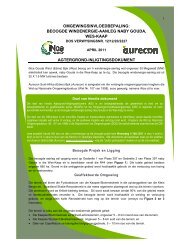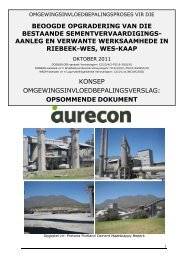Final EIAR - Aurecon AME Environmental | Environmental Projects
Final EIAR - Aurecon AME Environmental | Environmental Projects
Final EIAR - Aurecon AME Environmental | Environmental Projects
Create successful ePaper yourself
Turn your PDF publications into a flip-book with our unique Google optimized e-Paper software.
Proposed Wind and Solar (Photovoltaic) Energy Facilities on Kangnas Farm near Springbok in the Northern Cape: <strong>Final</strong> EIR 111<br />
should be addressed, implemented and monitored in terms of the EMP for the<br />
construction phase.<br />
• Any septic tanks constructed for the project should be located at least 100 m (measured<br />
from top of bank) from the ephemeral streams and at least 1 000 m away from the<br />
springs or any boreholes/wellpoints.<br />
• Storm water run-off infrastructure must be maintained to mitigate both the flow and water<br />
quality impacts of any storm water leaving the energy facilities site. Should any erosion<br />
features develop, they should be stabilised as soon as possible.<br />
The same measures as recommended for the proposed wind energy facility should be<br />
implemented.<br />
4.4.5 Impact on heritage resources<br />
Heritage resources include archaeological material (e.g. rock paintings, stone tools),<br />
palaeontological material (e.g. fossilised materials) and cultural heritage material (e.g. old<br />
graveyards, fences or ruins of buildings). Since some potential heritage material is buried, it is<br />
often only found during the construction phase of a project. A large scale development such as<br />
the proposed projects could have a negative impact on the archaeological and cultural heritage<br />
resources (including visual, landscape and sense of place impacts) by damaging or destroying<br />
such material or by requiring the material to be removed and stored in situ. As such a heritage<br />
impact study was undertaken by Mr Jayson Orton. A site survey was conducted from 23-<br />
28 July 2012. The Heritage Impact Assessment is included in Annexure H. The findings and<br />
recommendations of the study are summarised below.<br />
a) Description of the environment<br />
The landscape on and around the study area is dominated by two strongly contrasting<br />
components namely low rocky inselbergs and ranges of hills with flat grassland in between.<br />
During the site survey a large number of heritage occurrences were recorded.<br />
Pre-colonial archaeology<br />
The best pre-colonial sites are often found in caves. These are very rare in the Bushmanland<br />
landscape however four are located on the site. Two of these caves contain rock art, the third<br />
cave had only two quartz artefacts and the fourth cave was located in a small rocky valley and<br />
seemed to contain only light traces of occupation. These traces consisted of fragments of burnt<br />
bone, some fragments of ostrich eggshell and pottery and a few quartz flaked stone artefacts.<br />
The majority of archaeological sites recorded contained scatters of stone artefacts,<br />
predominantly in quartz (milky and clear) and cryptocrystalline silica (CCS) with silcrete,<br />
quartzite and other rocks more rarely represented (Figure 4.22: Stone artefacts that occurred<br />
near the base of hill on the western side of the site (J Orton, 2012))<br />
© <strong>Aurecon</strong> (2012) No unauthorised reproduction, copy<br />
or adaptation, in whole or in part, may be made.<br />
P:\<strong>Projects</strong>\108495 Kangnas WEF & PV EIA's\3 Project Delivery\4 Reports\FEIR\FEIR 210213 <strong>Final</strong>.doc


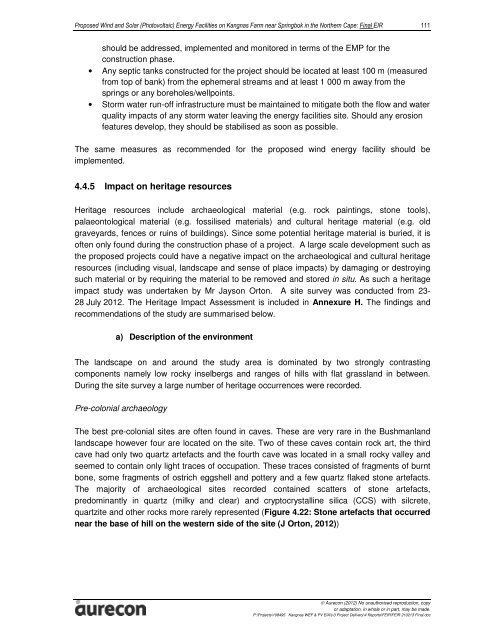
![CRR IV FEIR ~ 26042010 [FINAL].pdf - Environmental Projects](https://img.yumpu.com/21973020/1/184x260/crr-iv-feir-26042010-finalpdf-environmental-projects.jpg?quality=85)
